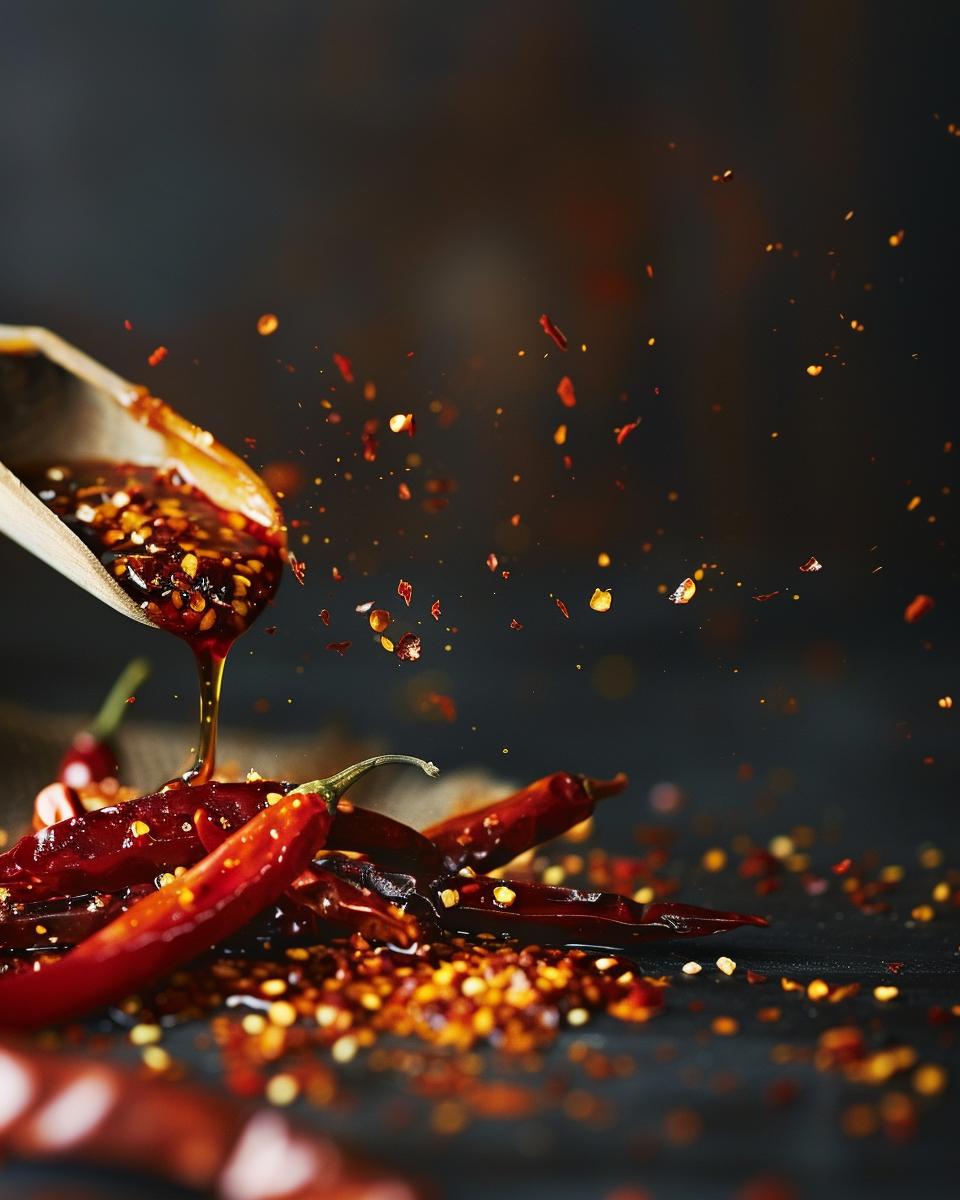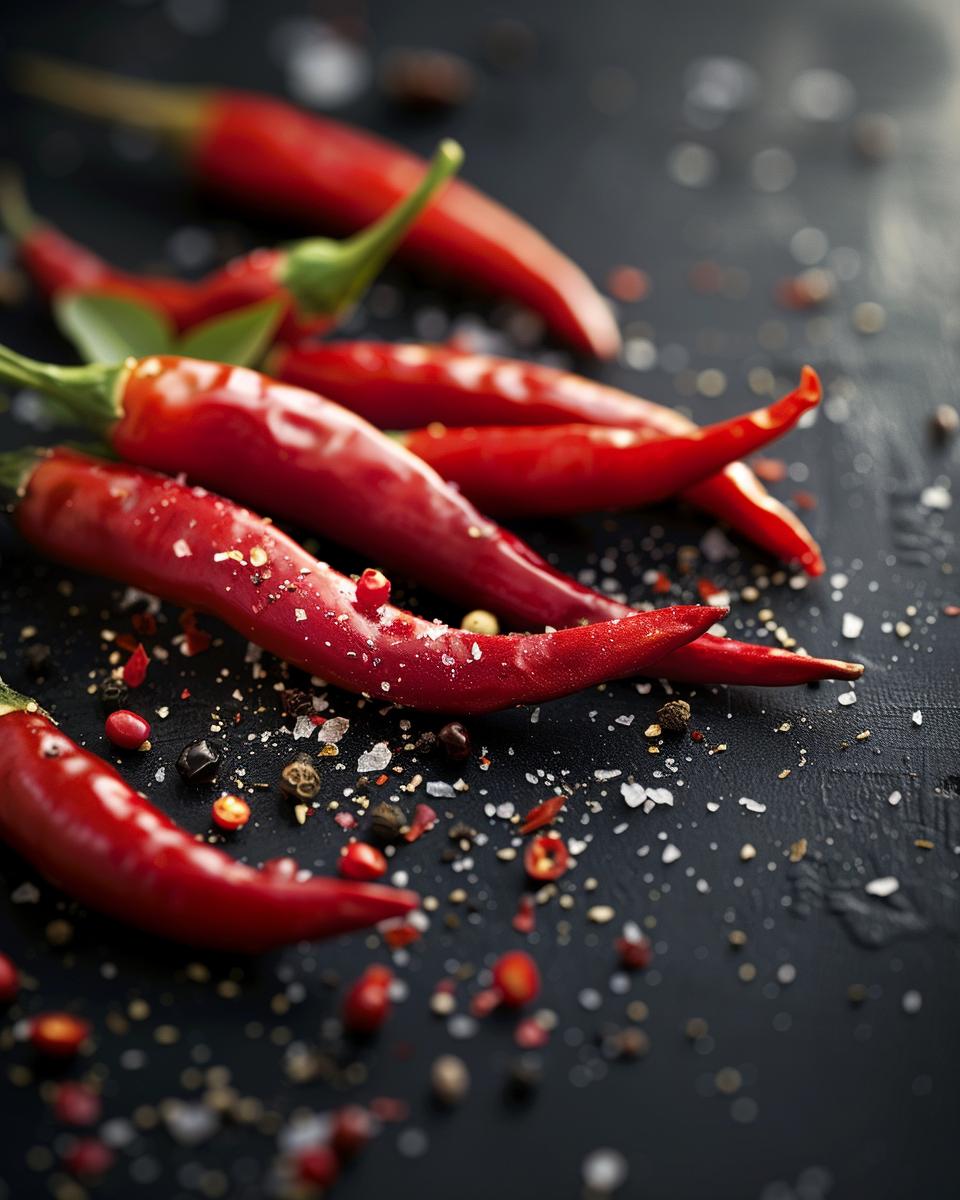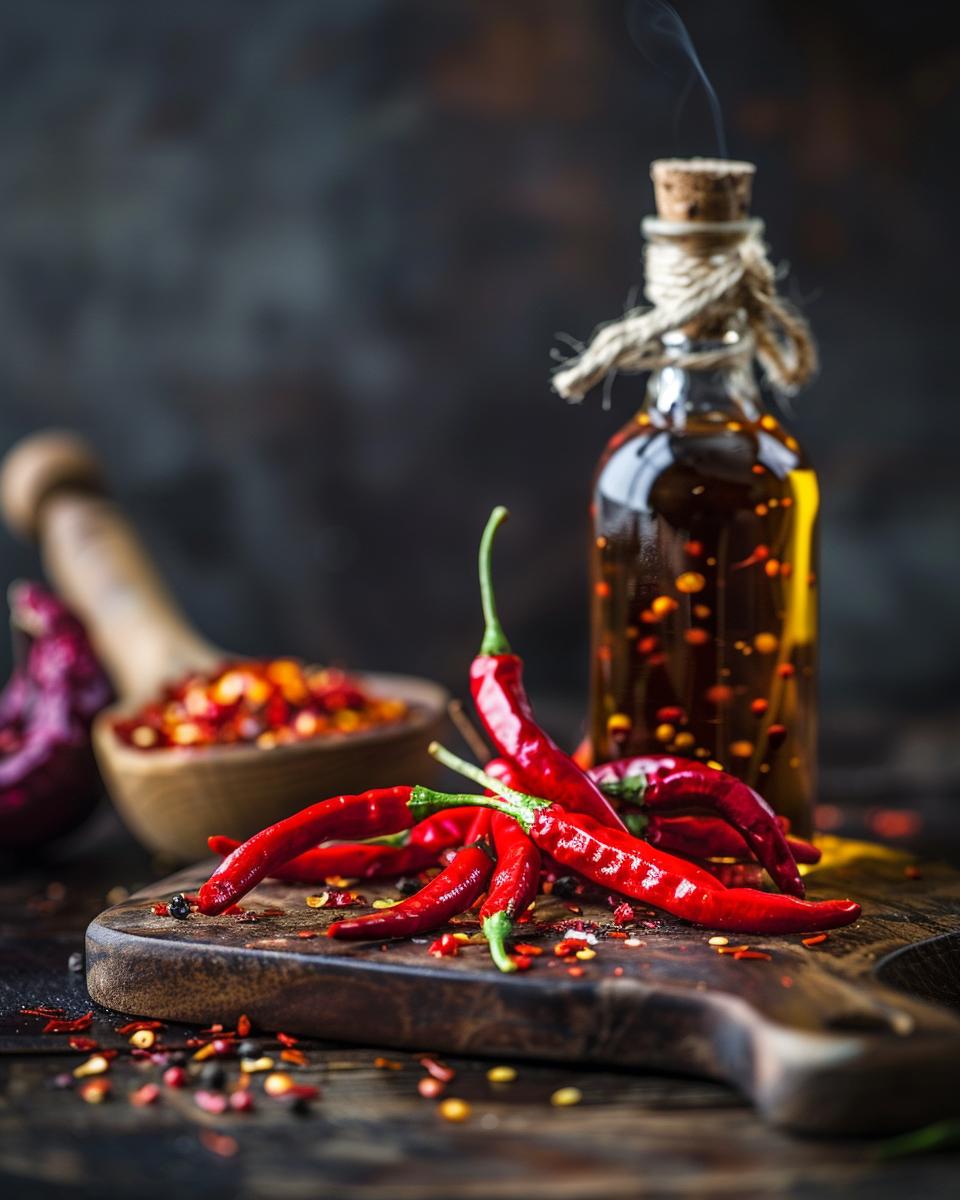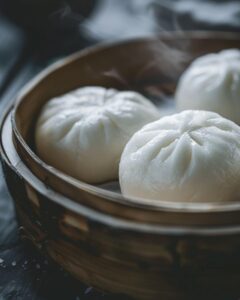Thai Chili Oil Recipe: Unleash a Burst of Uncommon Flavors
Ever longed for a condiment that truly transforms your meals? Our Thai chili oil recipe promises just that. It’s a simple yet exotic addition that will elevate your culinary creations with a burst of uncommon flavors. Imagine drizzling it over your favorite dishes to add a tantalizing heat that dances on your palate!
In this recipe:
- Discover the secret to authentic Thai chili oil
- Learn how to balance spicy, sweet, and savory notes
- Get tips on pairing it with your favorite dishes
Moreover, this fiery delight is surprisingly easy to make. Curious how it compares to other spicy concoctions? Check out our Chili’s Street Corn Recipe for a similar kick of heat. Or, when you crave something richer, our Uncommon Bourbon Chicken Mall Recipe is sure to impress. Both recipes promise to unleash unique flavors in your home cooking.
Now, let’s get started. With just a few ingredients and a bit of patience, you’ll have a jar of homemade Thai chili oil that’s bursting with flavor. It’s not just a condiment; it’s a gateway to an extraordinary culinary journey. Ready to dive in?

Who Can Master the Art of Thai Chili Oil
Whether you’re a cooking newbie or a seasoned kitchen warrior, the easy Thai chili oil recipe we’re about to share is for you. If you’re wondering, “Can I make this?” the answer is a resounding yes. This recipe is crafted to suit anyone eager to explore the robust flavors of Thailand from the comfort of their own kitchen.
Indeed, the process is straightforward. You need minimal equipment—just a saucepan, a spoon, and a jar for storing your spicy creation. It’s all about infusing high-quality oil with a blend of aromatic spices and fiery dried chilies. The outcome? An authentic Thai chili oil that captures the essence of Thai cuisine.
But what about the heat? Fear not! The beauty of homemade Thai chili oil lies in its adaptability. You control the spice level, making it as mild or as blazing as you wish. It’s your kitchen, your rules.
The Versatility of Thai Chili Oil
This condiment is not just about heat; it’s a symphony of flavors. You can adjust the recipe to include garlic, sugar, or even a squeeze of lime for added complexity. And its uses? Infinite. Drizzle it over noodles, stir-fries, or dumplings. Mix it into dressings or marinades. Each drop adds a depth of flavor that’s hard to replicate with any other ingredient.
For those looking for inspiration, The Woks of Life offers a treasure trove of recipes that pair perfectly with Thai chili oil. From Sichuan spicy wontons to a refreshing smashed Asian cucumber salad, your culinary journey will be both exciting and delicious.
So, embark on this flavorful adventure. With our guide, you’ll master the art of Thai chili oil and unveil a new world of taste sensations. Are you ready to start?
Essential Ingredients for Thai Chili Oil
Now that we’ve covered the simple equipment needed, let’s dive into the heart of our Thai chili oil recipe: the ingredients. Selecting the right components is crucial for achieving that vibrant flavor and aroma we’re after. Whether you’re a seasoned chef or a kitchen novice, these ingredients will transform your culinary creations.
Gathering Your Flavor Arsenal
What makes Thai chili garlic oil recipe so distinctive? It’s all about the combination of heat, zest, and richness. Here’s what you’ll need:
Garlic: 6 cloves, minced, for a pungent depth
Shallots: 2, finely chopped, for sweetness and texture
Neutral Oil: 1 cup (like vegetable or canola), as the carrier of flavors
Soy Sauce: 1 tablespoon, for a touch of umami
Sugar: 1 teaspoon, to balance the heat
Salt: 1/2 teaspoon, to enhance the overall taste
Each ingredient in our fresh Thai chili oil recipe contributes to the final taste. The chilies bring the heat, which is the soul of the oil. Garlic and shallots add complexity, while the neutral oil ensures a perfect infusion of flavors. Soy sauce and sugar create a savory-sweet dynamic, and salt rounds it all off.
Can’t find Thai chilies? No problem. Substitute with other red chili flakes or even fresh chilies if you prefer. If you’re watching your sodium intake, opt for low-sodium soy sauce. And for a sugar alternative, honey or agave syrup can do the trick. Remember, the best Thai chili oil recipe is one that suits your taste and dietary needs.

Your Step-by-Step Guide to Crafting Thai Chili Oil
Now that you’ve got your fiery ingredients ready, let’s dive into how to make Thai chili oil. Remember, we’re dealing with hot oil, so safety first! I’ll guide you through each step, offering tips to nail that perfect consistency and flavor. Ready to get sizzling?
- Heat the Oil: Begin by heating your neutral oil in a saucepan over low heat. You want to warm the oil without reaching its smoking point. Aim for a gentle heat, around 225-250°F (107-121°C).
- Prepare the Chilies: While the oil is heating, finely chop or crush your dried Thai chilies. The size of the chili flakes will affect the oil’s intensity, so go as fine or as coarse as you like for your spicy Thai chili oil recipe.
- Combine Oil and Chilies: Once the oil is warm, carefully add the chilies into the saucepan. Stir them occasionally, ensuring they infuse evenly. You’ll notice the oil gradually adopting a vibrant red hue—a visual cue that your chili oil is coming to life.
Final Touches and Cooling
Continuing with our Thai chili oil stir fry recipe:
- Monitor the Heat: Keep an eye on the heat level. The chilies should sizzle softly, but never smoke or burn. If they do, immediately remove the saucepan from the heat to prevent a bitter taste.
- Cooling Down: After about 5 minutes of infusing, remove the saucepan from the heat. Let the oil cool down to room temperature, allowing the flavors to meld further.
- Strain or Not: Depending on your preference, you can strain the chilies out or leave them in for an extra kick. Either way, you’ll have a deliciously spicy condiment.
- Storage: Transfer the cooled chili oil into a clean, dry jar. If stored properly in a cool, dark place, your homemade Thai chili oil can last for up to a month.
So, did you find the process easier than you thought? With these steps, you’re well on your way to enjoying a homemade Thai chili oil that’s sure to spice up any dish. Remember, the key to the perfect chili oil is patience and precision—don’t rush the infusion, and always handle hot oil with care. Enjoy your flavorful creation!
Serving and Storage Solutions for Thai Chili Oil
Now that you’ve mastered the art of making Thai chili oil, let’s turn that aromatic concoction into a culinary staple at your table. Whether you’re a kitchen novice or a seasoned chef, these next steps will ensure your chili oil is not only delicious but also safely stored for future use. Ready to elevate your meals with a spicy kick?
Getting the Most Out of Your Chili Oil
First things first, let’s talk about serving. Your homemade Thai chili oil is incredibly versatile. Drizzle it over dumplings or stir it into your favorite Thai chili oil dipping sauce recipe for an instant flavor boost. But why stop there? Transform a simple salad by whisking your chili oil into a zesty Thai chili oil salad dressing recipe, or toss it with crispy wings for a Thai chili oil recipe for wings that will be the talk of your next gathering.
When handling your freshly made chili oil, remember to always use clean utensils to avoid contamination. And as for storage, ensure your chili oil cools down completely before transferring it to a glass jar or bottle. A well-sealed container is key to maintaining freshness and preventing any unwanted spills.
Store your chili oil in a cool, dark place to preserve its vibrant color and pungent flavors. The back of your pantry or a kitchen cupboard away from heat sources is ideal. But if you’ve made a large batch, consider refrigerating it to extend its shelf life even further.
Keep an eye out for visual cues like changes in color or any signs of spoilage. Typically, a well-made and properly stored chili oil can last for up to six months. So, why not make a little extra? After all, having a jar of this fiery condiment on hand means you’re always just a spoonful away from adding depth and excitement to any dish.
Are you ready to transform your meals with the bold flavors of homemade Thai chili oil? Follow these simple tips for serving and storage, and you’ll be a chili oil aficionado in no time!

Pro Tips for Perfecting Your Thai Chili Oil Recipe
- Always start with dry chilies to prevent splattering during heating.
- For a deeper flavor, toast spices before infusing them into the oil.
- Gradually heat the oil to avoid burning the delicate chili flakes.
- Similarly, let the oil cool slightly before adding garlic to prevent bitterness.
- Moreover, strain the oil if you prefer a smooth texture in your dishes.
- Additionally, use a thermometer to ensure the oil reaches but does not exceed 180°C (350°F).
- Finally, store the oil in a dark, cool place to maintain its vibrant color and pungency.
Frequently Asked Questions About Thai Chili Oil
Embarking on your Thai chili oil journey? Here are some common queries that might pop up along the way. We’ve got you covered with detailed answers to enhance your cooking experience!
Ingredient Replacements and Allergies
Can I use a different oil instead of olive oil for my Thai chili oil? Absolutely! While Thai chili olive oil is popular, feel free to substitute it with other neutral oils like canola or vegetable oil. They’re great for those with olive oil allergies or preferences.
What if I can’t find Thai chilies? No worries! Other hot chilies can work, though they’ll alter the flavor slightly. Just remember, the heat level might vary, so adjust according to your taste.
Is there a nut-free alternative for peanut oil in chili oil recipes? Yes, for those with nut allergies, sunflower or grapeseed oil are excellent nut-free options that maintain the chili oil’s character.
Money-Saving Tips and Flavor Enhancement
How can I make chili oil on a budget? To save money, buy chilies in bulk and look for sales on your base oil. Homemade Thai chili oil also tends to be more cost-effective than store-bought versions, and you can control the ingredients!
Any tips for enhancing the flavor of my Thai chili oil? Toasting the spices before infusing them into the oil can release more flavor. Also, consider adding aromatics like garlic or shallots for extra zing. Check out this guide on making chili oil for more inspiration.
Whether you’re drizzling it over noodles or using it as a base for a Thai chili oil dressing recipe or vinaigrette, these tips will ensure your chili oil is both delicious and budget-friendly!












